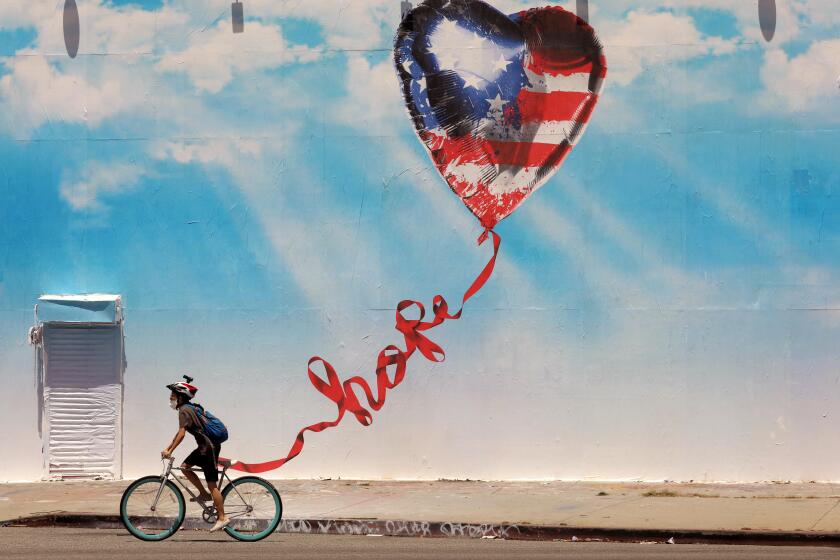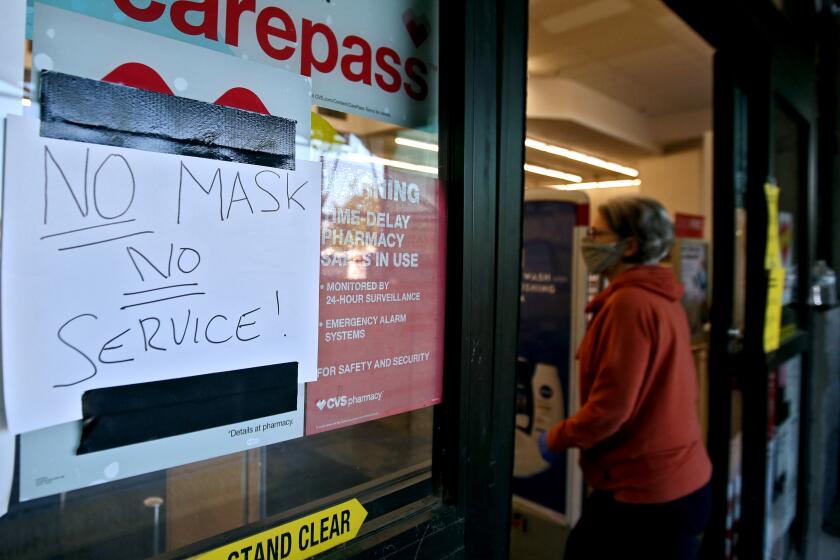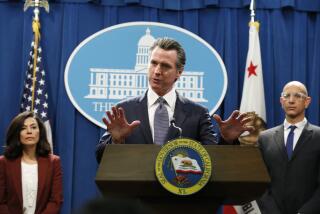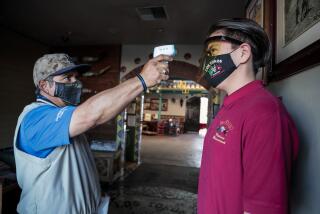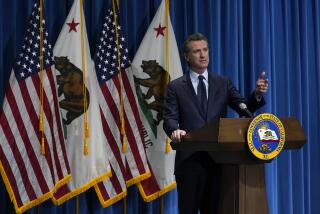Restaurant dining rooms, wineries, card rooms to close for at least three weeks in 19 California counties
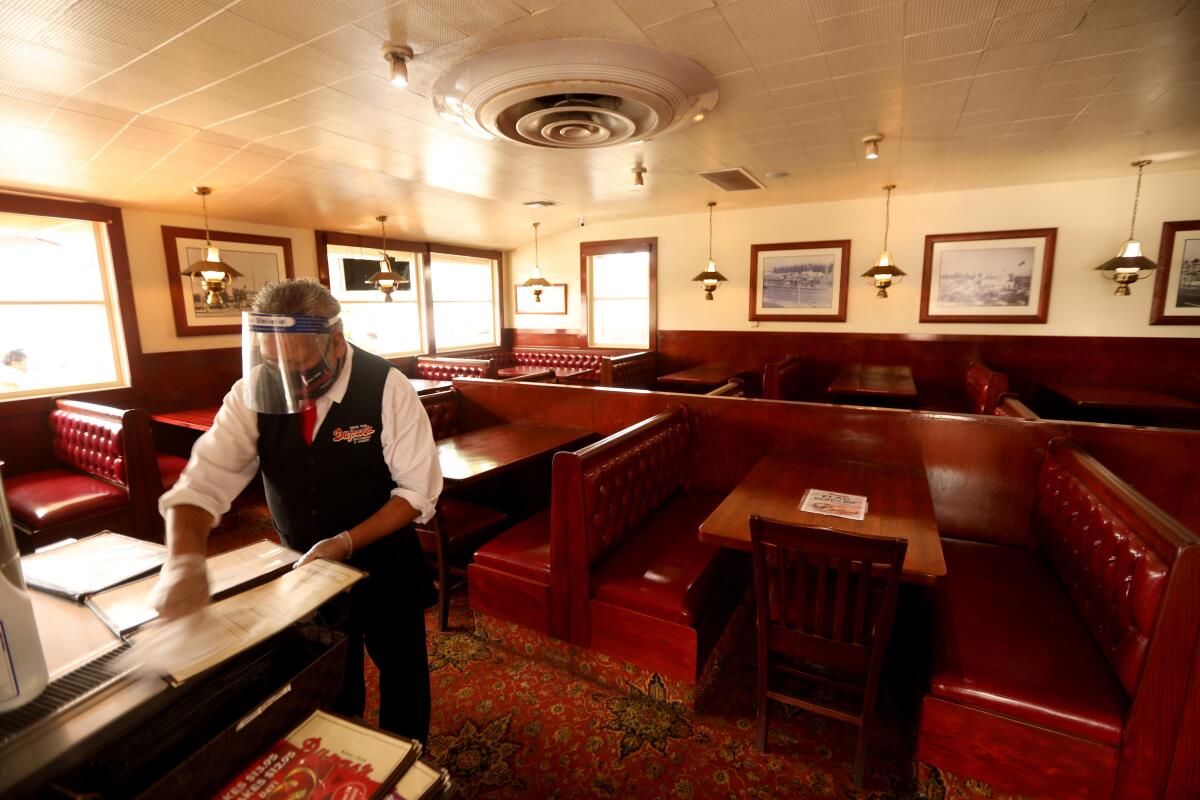
- Share via
SACRAMENTO — Gov. Gavin Newsom on Wednesday ordered tougher restrictions on indoor activities for most of the state, marking a major step backward in the reopening and an attempt to slow an alarming rise of the coronavirus in 19 counties.
The governor took action to halt visits to indoor restaurants, bars, wineries and tasting rooms, entertainment centers, movie theaters, zoos, museums and card rooms for the next three weeks in Los Angeles, Riverside, Ventura, Orange, San Bernardino and Sacramento counties and other regions hard hit by the virus.
Newsom is imposing the restrictions in an effort to reduce opportunities for people to gather indoors in advance of the July 4 holiday weekend, when officials fear disaster if Californians continue to ignore safety guidelines and businesses remain open in areas already experiencing significant spikes in coronavirus infections.
Gov. Gavin Newsom on Wednesday ordered tougher restrictions on indoor activities for most of the state, marking a major step backward in the reopening and an attempt to slow an alarming rise of the coronavirus in 19 counties.
As of Wednesday at 5 p.m., there were 237,068 confirmed cases of COVID-19 in California, following record increases earlier in the week, and 6,152 total deaths, according to data tracked by The Times.
“We have to be much more vigilant in terms of maintaining our physical distancing from others and be much more vigilant as it relates to the prospects of being in situations where we are transmitting COVID-19,” Newsom said. “The decisions we’re making here today — we do so soberly but thoughtfully and deliberately with an idea on mitigating the spread of this virus.”
The change signals a reversal in the state’s reopening that began in early May and quickly progressed by June 12 to allow retail stores, dine-in restaurants, bars, religious services, hair salons, gyms and other businesses to open again with modifications in counties that met state guidelines.
Newsom is also recommending the cancellation of all fireworks shows on the Fourth of July in the affected counties, and is urging Californians to rethink having large get-togethers with friends and neighbors to celebrate the holiday.
As workplaces reopen amid the coronavirus pandemic, we want to hear from readers.
The governor emphasized that the new mandates would allow businesses to remain open for outdoor service and takeout. Bars and other drinking establishments in the affected counties are also allowed to seat guests outdoors as long as they sell a meal with drinks in the same transaction and meet all of the same safety requirements as restaurants.
The state applied the closures to counties that have been flagged for at least three consecutive days based on troubling longer-term data on key public health metrics, including hospitalizations, community transmission and hospital capacity. The state has been using the data to determine when counties are safe to open businesses and now to decide when to “toggle back,” as Newsom has described the process of reversing course and closing down.
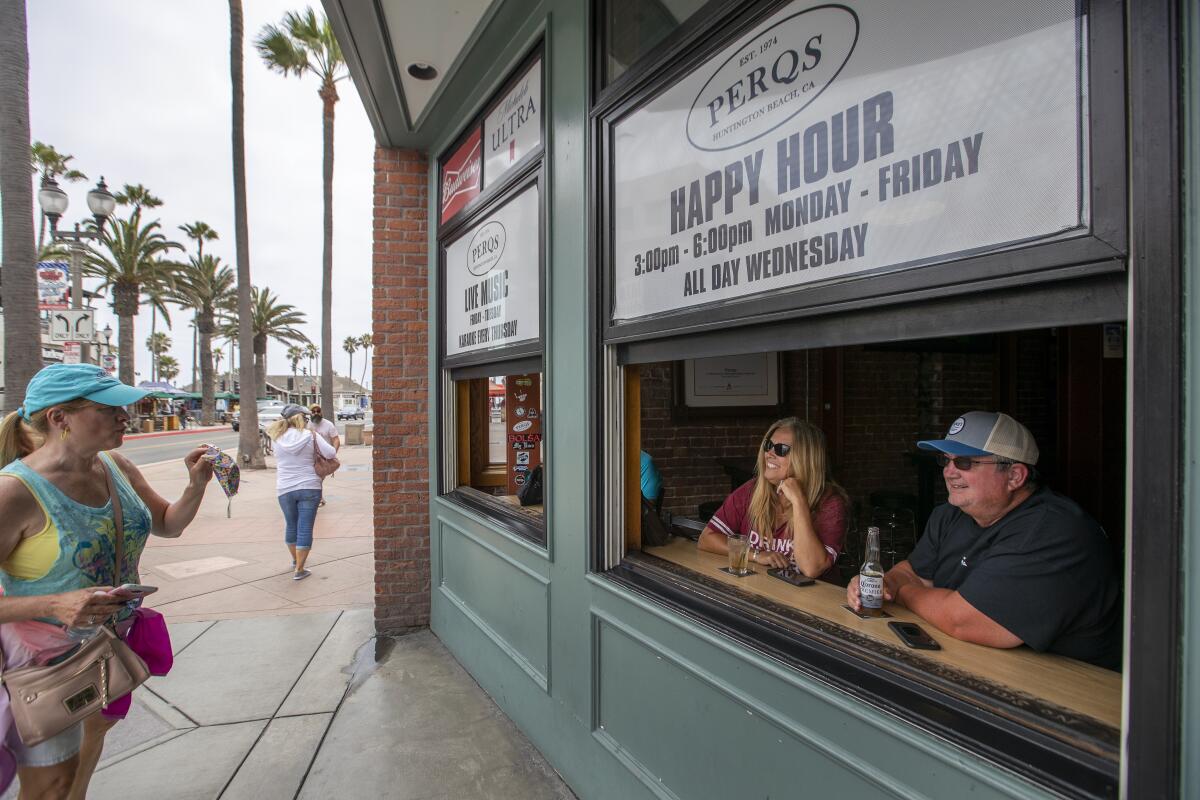
Newsom’s order immediately applies to the affected indoor business activities in Contra Costa, Fresno, Glenn, Imperial, Kern, Kings, Los Angeles, Merced, Orange, Riverside, Sacramento, San Bernardino, San Joaquin, Santa Barbara, Santa Clara, Solano, Stanislaus, Tulare and Ventura counties.
State officials have long anticipated that reopening would lead to an increase in cases and risk of more deaths as Newsom shifted power to counties in May to open businesses at their own pace.
Newsom began sounding the alarm about the growing spread of the virus on June 18 by requiring Californians to wear masks or other face coverings in public and high-risk settings. But the state continued to speed up the reopening process and allowed personal care services in one of the highest-risk sectors, such as nail salons, massage parlors, tattoo shops and waxing services, to resume the next day.
The governor defended his administration’s approach to reopening the state’s economy on Wednesday, saying it relied heavily on local public health officials to assess the severity of the outbreak in their areas and to determine the safest approach.
He has continually said that the initial stay-at-home order allowed the state to ensure there was adequate hospital capacity along with personal protective gear, ventilators and other necessary medical supplies to handle a surge.
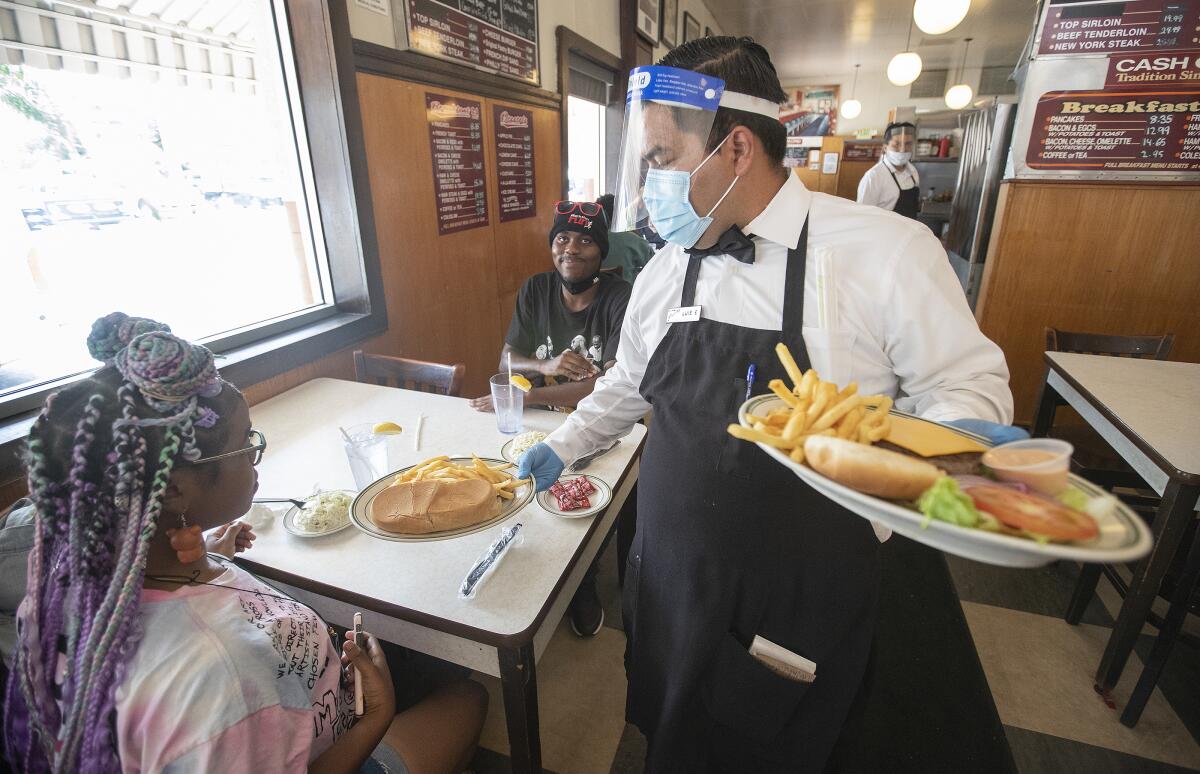
.
“The whole purpose of the original stay-at-home was to buy us time, not put us into a permanent state of closure,” Newsom told The Times. “No one advertised that we would shut down the fifth-largest economy for a year. That would create a health crisis the likes of which the nation has never seen in history.”
So far, the reopening has resulted in a surge in cases and hospitalizations that could threaten the progress the state made during the shutdown.
After local health officials tied the flood of new cases to infections around Memorial Day, Newsom took action on Sunday to “toggle back” reopening for the first time and demanded a limited closure of bars in seven counties that are experiencing increases in virus transmission.
Under criteria to reverse reopening at the local level, a county is flagged and placed on the state’s watch list if it reports an elevated transmission of the disease, defined as more than 100 cases reported per 100,000 residents over two weeks, or more than 25 cases per 100,000 residents in two weeks and a positivity rate of at least 8% of tests concluded over one week.
A spike in hospitalizations of more than 10% over three days compared to the prior three days, or a drop in hospital capacity to fewer than 20% of beds, or fewer than 25% of ventilators available could also result in a county landing on the watch list.
The state is providing outreach to counties experiencing trouble. State guidance says such counties should consider adopting parts of the stay-at-home order again if they fail to make progress on containing the disease or lowering hospitalizations, or the state public health officer may take action to do so for them.
Newsom has so far resisted using a heavy-handed approach when it comes to enforcing his coronavirus restrictions, however, choosing instead to encourage compliance and educate residents about the benefits of safeguards against spread of the virus.
Still, he has threatened to cut coronavirus funding for counties earmarked in the newly enacted state budget, invoking provisions in the spending plan that link compliance with COVID-19 guidelines to cash distributed to counties each month.
Newsom said he was not “Pollyannaish” about the difficultly in enforcing the restrictions in a state as large and diverse as California.
“You have 40 million people in the state of California and if 40 million people turn their back on these guidelines and common sense, that is not something we can enforce,” Newsom said. “No one is naive about that and we can beat our heads against the wall and say ‘I told you so,’ but that’s not going to sit well and I don’t want to do that.”
Newsom said that even during the Fourth of July holiday, state agents will go after businesses that are “thumbing their nose” at the state-imposed restrictions and putting customers and employees at risk.
He said the state has put together a strike team composed of agents from seven different agencies, including Division of Occupational Safety and Health, the Department of Alcoholic Beverage Control and the boards that regulate barbers and salons.
“Why have rules, why have regulations, why have laws if you’re not willing to enforce? One must be willing. So it’s targeted. It’s where there are abuses,” Newsom said.
The state will rely heavily on local governments to enforce the coronavirus restrictions and, overall, most have been cooperative, Newsom said.
Brian Vaughan, the public health officer in Northern California’s Yolo County, said that an uptick in coronavirus cases has always been planned for, especially since many epidemiological experts expected another surge in COVID-19 infections to hit eventually. In an interview in June, Vaughn, said he expects residents to understand the severity of the situation and to act accordingly if tougher restrictions are reimposed.
“The seriousness in which our community has addressed it was a huge reason why we were able to flatten our curve and we didn’t see a big spike,” Vaughn said. “So I would assume that, if we’re being transparent we’re sharing our data, and things start ticking up in terms of infections that the community would be behind us.”
Imperial County in the southeast corner of California remains one of the state’s hardest hit areas. Last week, nearly one of every four people tested in Imperial County has been positive for the coronavirus over a 14-day period, far above the statewide average of one in every 20 residents.
More than 500 hospital patients have been transferred out of the county to relieve pressure on medical facilities in the rural county. Newsom recommended the county reimpose a strict stay-at-home order, mandating that all residents not classified as essential workers remain at home expect for trips to buy groceries, seek medical care and care for other critical needs.
The Imperial County board of supervisors on Monday released a plan to reimpose the restrictions, which is awaiting approval from the Newsom administration.
The governor’s mask order also faced backlash in some parts of the state almost immediately. Sheriffs in Orange, Riverside, Fresno and Sacramento counties, among others, said they would not enforce the Newsom administration’s mask order despite the fact that violating the mandate is a misdemeanor and could financial penalties.
More to Read
Sign up for Essential California
The most important California stories and recommendations in your inbox every morning.
You may occasionally receive promotional content from the Los Angeles Times.
